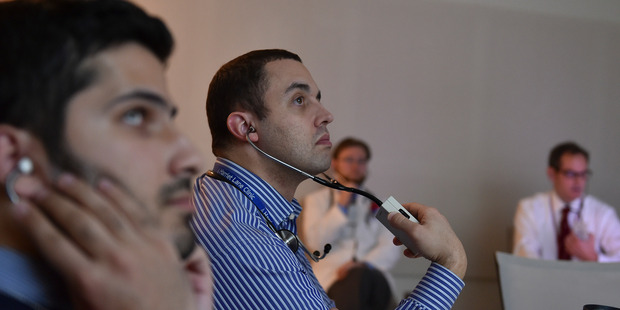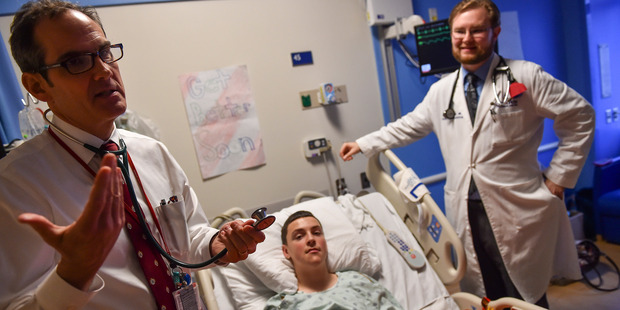When one of my best friends in medical school returned from an interview for a surgical residency program, he told me how some of the surgeons there bragged that they were worked so hard that the divorce rate among their trainees was greater than 100 percent — some of them burned through two marriages.
They were proud of this. I was horrified.
I doubt this statistic was true, even 20 years ago, and I’m even surer it’s not true now. But it points to an important truth: Some physicians equate “suffering” with “commitment” and believe that a residency should be grueling and difficult.
A resident is a physician having further on-the-job training after medical school. When I was one, I regularly worked 80-plus hours a week. When I was in the Infant Intensive Care Unit, I was on q3, meaning that in addition to working 12-hour days, I worked every third night between them as well. In a bad week, I could easily work more than 90 hours. And I was a pediatrician. Many specialties, like surgery, have it far worse.
Personally, I couldn’t believe this was good for patient care. Others agreed. In 2003, the Accreditation Council for Graduate Medical Education passed new regulations that capped resident hours at 80 hours per week, and also limited shift lengths and required time off between shifts. In 2011, these were strengthened to further limit the time that interns, or first-year residents, could work.
There are other people in the health care industry who believe that such changes are bad for patient care. Reducing hours and shortening shifts means that doctors have to hand off patients to one another more regularly. Things could get missed. Doctors who are coming on might not understand the patients as well as those who are coming off. Perhaps reducing work hours is bad for patients.
Most evidence does not support this claim. A systematic review found that patient health did not improve after duty hours were restricted, but few studies found that it worsened.
Beyond patient health, there have been concerns that reduced hours might result in worse education. Residents with reduced hours would miss lectures. Surgical residents might be forced to leave procedures. These concerns make sense, but most evidence doesn’t support the claim that education is being harmed either.
A recent study published in the New England Journal of Medicine brings us new answers. This was a national study of 117 general surgery residency programs in 2014 and 2015. Programs were randomized to one of two work-hour policies. The first was “traditional”: Interns could not work more than 16 hours straight. Other residents could not work more than 28 hours straight (24 for “work” and 4 for “transition”).
All residents had to have at least eight (but preferably 10) hours off between shifts, 14 hours if they’d just worked a 28-hour shift. Residents couldn’t work on average more than 80 hours a week over four weeks. They had to have one full day off every seven days over four weeks, and they couldn’t be on call more than every third night.
The other group was assigned the new “flexible” policy. In that one, interns could work more than 16 hours straight, and residents could work more than the 24/28 hours straight. They weren’t required to have the 8 to 10 hours off, or the 14 hours off after a long shift. They still couldn’t work more than 80 hours a week averaged over four weeks, however. They still had to have one day off for every seven, and they still couldn’t be on call more than once every third night. In other words, residents in the “flexible” policy still had maximum hours capped and days off required, but could work longer hours per shift to avoid missing procedures or having to hand off patients if they didn’t want to.
Data were analyzed on almost 139,000 patients. The rates of death and/or serious complications were 9.1 percent in the flexible-policy group and 9 percent in the standard-policy group. The flexible-policy group was not inferior. The concerns we might have about patients being hurt if doctors worked longer shifts do not appear to be well supported by data, at least using these criteria as “hurt.”
Continue reading the main story
What about satisfaction? Of the 4,330 residents studied, 11 percent of the flexible-policy group and 10.7 percent of those in the standard-policy group reported dissatisfaction with the overall education, essentially no difference. With respect to well-being, almost 15 percent of those in the flexible-policy group and 12 percent of those in the standard-policy group reported dissatisfaction. Again, hardly a difference. Moreover, residents in the flexible-policy group were less likely to report negative effects of duty-hour policies on patient safety, continuity of care, professionalism and resident education. They were also less likely to have to leave in the middle of an operation (7 percent vs. 13.2 percent) or to report having to hand off patients in the middle of continuing problems (32 percent vs. 46.3 percent).
The flexible-policy doctors were, however, more likely to report negative effects on personal activities.
The authors’ conclusions gave me the impression that since giving residents more flexibility, like working longer shifts, did not increase complication rates and seemed acceptable to residents, the complaints of those who demand that residents be protected are overblown. We should let them work more and not interfere. It’s safe and feasible.
I’m not sure I agree. Another way to look at this is that holding residents to relatively shorter shifts didn’t result in higher rates of death or complications in patients either. Given that there don’t appear to be patient harms, the only reason to switch is because you believe it’s better for residents. It’s hard to imagine that’s true.
Further, asking the residents what they think may not be the best way to determine if that’s the case. Residency programs have a way of indoctrinating new recruits into believing that misery is somehow noble.
A better metric, and one that we should all care about, is whether resident surgeons are less well trained and skilled when they come out of residency now than before. I’ve heard plenty of anecdotes to support this notion from colleagues, but I’ve seen no good evidence to prove it. Without good data, it feels more like the usual griping each generation seems to have about being the last great one.
The concerns of those training physicians are valid and should not be ignored. However, if patients aren’t harmed and education doesn’t suffer, we should probably err on the side of treating our doctors-in-training as benignly as possible. As I’ve discussed before, depression and other mental health problems are already common enough during training. We want to be sure that as we create doctors, we aren’t sacrificing human beings.
source: nytimes





 W. Reid Thompson, a pediatric cardiologist and associate professor of pediatrics, encourages students to hone their listening skills to make better decisions. Photo / Washington Post, Ricky Carioti
W. Reid Thompson, a pediatric cardiologist and associate professor of pediatrics, encourages students to hone their listening skills to make better decisions. Photo / Washington Post, Ricky Carioti